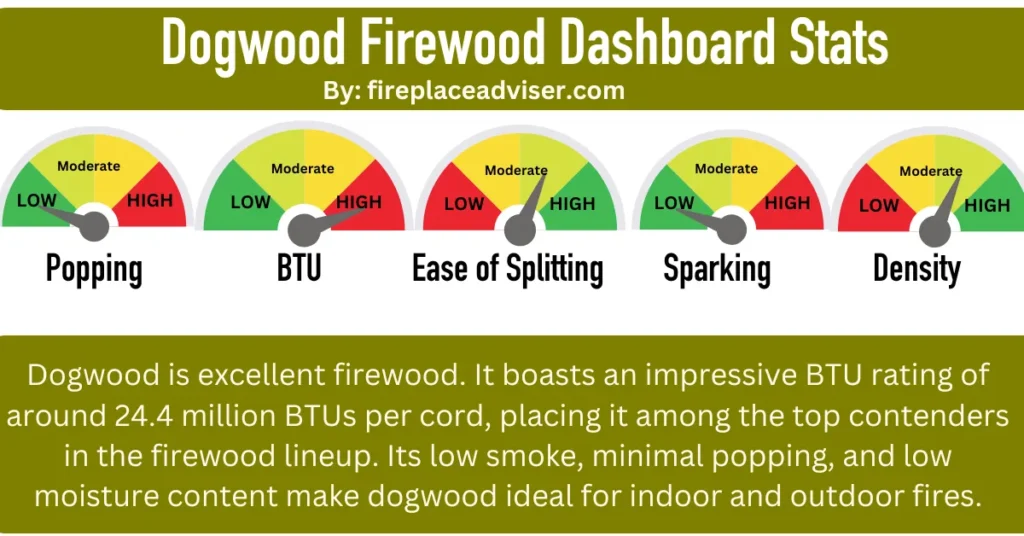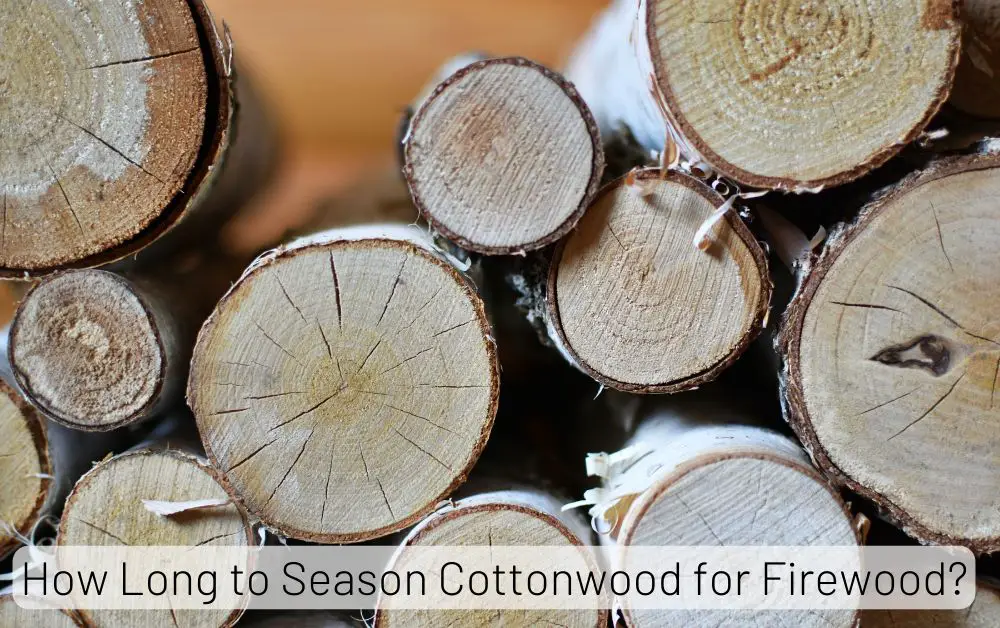The options can seem endless when selecting firewood for your fireplace or wood-burning stove. Amidst the array of choices, one often overlooked contender is Dogwood. Revered for its vibrant spring blossoms and striking autumn foliage, dogwood trees are more commonly associated with ornamental beauty rather than practicality. However, the question remains: is dogwood good firewood?
Dogwood is excellent firewood. It boasts an impressive BTU rating of around 24.4 million BTUs per cord, placing it among the top contenders in the firewood lineup. Its low smoke, minimal popping, and low moisture content make dogwood ideal for indoor and outdoor fires.
In this exploration, we delve into the qualities of Dogwood as a fuel source, considering its density, burn characteristics, and overall suitability for heating purposes.
Let’s unravel the mysteries surrounding this underappreciated wood species and determine whether it deserves a spot in your firewood stash.
Overview
| Dogwood Firewood Characteristic | Description |
|---|---|
| BTU | High (27.4 million BTUs per cord) |
| Smoke | Low |
| Popping | Low |
| Sparking | Low |
| Seasoning | Relatively easy |
| Splitting | Moderately easy |
| Moisture Content | Low |
| Fragrance | Pleasant |
| Density | High |
| Burn Time | Long |
| Resin Content | Low |
| Availability | Generally abundant |
About Dogwood Firewood
Dogwood, known for its vibrant spring flowers and striking red stems in winter, is a deciduous tree found worldwide. While primarily valued for its ornamental beauty, dogwood also serves as a potential source of firewood.
Is Dogwood Good Firewood?
Absolutely! Dogwood is good firewood and a top choice for efficient and long-lasting fires. With a high density and excellent BTU output, dogwood burns hot and clean, making it ideal for heating. Dogwood boasts an impressive BTU rating of around 27.4 million BTUs per cord, placing it among the top contenders in the firewood lineup.
Not only does dogwood provide ample heat, but it also burns slowly, ensuring that your fire lasts longer. This maximizes its efficiency and minimizes the need for constant refueling.
Its dense nature produces less smoke and sparks than other types of firewood, making it a safer and more environmentally friendly option for your fireplace or wood stove.

Dogwood Firewood Pros and Cons
Pros:
- Dogwood is known for its dense nature, allowing it to produce significant heat when burned. This makes it practical for heating purposes, especially during colder months.
- Dogwood firewood burns slowly and evenly, providing a long-lasting heat source. This can be advantageous for maintaining warmth over extended periods without constantly tending to the fire.
- When burned, dogwood emits a sweet and fragrant aroma, enhancing the ambiance of the space where it is being used for heating or cooking.
- Dogwood typically produces less smoke than other types of firewood, resulting in a cleaner burn and reduced air pollution.
- The pleasant aroma and steady heat output of dogwood make it suitable for cooking over an open flame. It imparts a subtle flavor to grilled or smoked foods.
Cons:
- Dogwood trees may not be as abundant in certain regions as other types commonly used for firewood. This can make dogwood firewood less readily available and potentially more expensive.
- While dogwood’s density contributes to its high heat output, it also makes it harder to split and may require more effort to prepare for use as firewood.
- Due to its density and slow growth rate, dogwood firewood may be more expensive than other types of firewood.
- Dogwood firewood must be seasoned appropriately to achieve optimal burning efficiency and reduce creosote buildup in chimneys. This process can take several months and requires storage space and advance planning.
- Dogwood trees are native to certain parts of North America and may not be readily available in other regions, limiting some individuals’ access to this type of firewood.
Related Post: Is Black Cherry Good Firewood?
Moisture Content
Like all firewood, dogwood’s moisture content significantly impacts its burning efficiency. Green or freshly cut dogwood contains high moisture levels, hindering combustion and producing excessive smoke.
Proper seasoning is essential to reduce moisture content and enhance burning performance.
Seasoning Dogwood Firewood
To optimize its burning qualities, dogwood firewood should be seasoned adequately. This process involves storing the wood in a dry, well-ventilated area for an extended period, typically six months to a year.
Properly seasoned dogwood will have a lower moisture content, resulting in cleaner, more efficient combustion.
Tips for Burning Dogwood
- Start with dry, seasoned wood for optimal combustion.
- Use kindling to ignite the fire quickly.
- Maintain proper airflow in the fireplace or stove to ensure efficient burning.
- Regularly remove ash buildup to prevent airflow obstructions.
Precautions and Safety Measures
- Install and maintain smoke detectors and carbon monoxide alarms.
- Have chimneys and flues inspected and cleaned annually.
- Keep flammable materials away from the fireplace or stove.
- Supervise fires and extinguish them completely before leaving them unattended.
Common Myths About Dogwood Firewood
- Myth: Dogwood produces excessive smoke.
- Reality: Properly seasoned dogwood burns cleanly with minimal smoke emission.
- Myth: Dogwood lacks heat output.
- Reality: While not as potent as some hardwoods, dogwood provides steady heat and long-lasting coals.
- Myth: Dogwood is challenging to ignite.
- Reality: Dogwood ignites easily and burns consistently with proper preparation.
Related Post: Why Are Roaches Coming From Fireplace?
FAQs
Is dogwood suitable for cooking fires?
While dogwood burns cleanly, it’s not recommended for cooking fires due to the potential for residual sap or natural toxins in the wood.
Can dogwood be used in wood-burning stoves?
Yes, dogwood is compatible with wood-burning stoves, provided it’s correctly seasoned and used with other firewood as needed.
Does burning dogwood contribute to deforestation?
Responsible harvesting practices and selective cutting can mitigate the impact of dogwood firewood production on forests.
How long does it take to season dogwood firewood?
Dogwood typically requires six months to a year of seasoning to achieve optimal moisture content for efficient burning.
Can dogwood firewood be used in outdoor fire pits?
Yes, dogwood firewood is suitable for outdoor fire pits. It offers a pleasant ambiance and steady heat for gatherings and recreational fires.
Final Thoughts: Is Dogwood Good Firewood?
In conclusion, dogwood can serve as good firewood, offering a balance of qualities that make it a viable option for heating and ambiance. Its dense composition, ease of ignition, and minimal smoke production make it a desirable choice for indoor and outdoor fires.
By understanding its characteristics and employing proper burning techniques, you can effectively harness dogwood firewood’s warmth and beauty.
Affiliate Disclosure: Fireplaceadviser.com is a participant in the Amazon Services LLC Associates Program. We may earn a commission when you click on certain links on this site and purchase.

Hello!! I am Jamal Khan. I often fix my home electric heaters and gas stove problems and research the common issues in the heating units to improve my knowledge and expertise. The aim of establishing fireplaceadviser.com is to share my expertise and knowledge with my audience.


















